Getting into the Halloween spirit, I did a segment on “Good Day Sacramento” about evil, spooky, and devious plants. There are no evil plants really… just misunderstood ones. Their evilness comes mostly from defensive chemical compounds. Isn’t this how a lot of people live their lives, hurt others before you get hurt? Hey, I’m not saying it’s right – just a defense mechanism! I included some of the UC Davis Botanical Conservatory’s most spooky and evil plants below. I can’t promise you won’t have nightmares!!
Good Day Sacramento Spooky Plants
Bullhorn Acacia – Acacia hindsii: Ants may be a nuisance to us but for many plants they could be necessary for survival. One such symbiotic relationship ( I rub your back, you rub mine) is between the Bullhorn Acacia and ants. The Acacia ants live in the hollow thorns and feed on Beltian bodies aka “protein bars” and nectar droplets the tree provides on its leaflets. In turn, the ants protect the tree from being eaten by anything else. The best way to go about describing the deviousness of this plant is to tell the story about the UC Davis Botanical Conservatory’s former director, Tim Metcalf, and this one evil plant. While in Mexico, plant hunting, Tim was shown a cycad he was searching for. In typical “Tim fashion”, he got really excited and proceeded to jump with joy. What he forgot to take into consideration was that he was jumping underneath a 30′ tall Bullhorn Acacia. Well, the ants living in the tree (possibly tens of thousands) felt the vibrations, thought something was trying to eat their home, and they proceeded to attack. They didn’t bother to climb down the trunk of the tree; oh no, they just dropped right down onto poor Tim. Ants are smart and confusing their enemies is what they do. Immobilizing quickly, they went straight for Tim’s eyes. These are not our little Argentinean ants but large, stinging ants. They stung him repeateledy and his eyes swelled up to the point he could not see. Luckily, he got away and his eyes went down in puffiness. Knowing Tim, he probably considered himself lucky to experience this. Other victims might not be so lucky.
I like to make visitors squirm by telling them that Africa is also where Acacias have symbiotic relationships with ants, and that the ants find their way up into the trunks of elephant’s noses. An urban legend I tell involves a parachutist who had the unlucky experience to land into one such tree. Not only was he tangled up in the horrendous thorns but the ants came out and they stung him to death. Hmmmmm not sure where he was parachuting but it makes a fantastic story!
Poison tree – Euphorbia virosa: “It’s what’s inside that counts.” “Don’t judge a book by its cover.” These all prove true with the plants in the Euphorbiaceae family, the Spurges. Plants in this family range from harmless-looking… such as the Poinsettia to very spiny and scary – many could be found in the deserts of the world. Compared to cacti, they look safer to eat and to obtain water from. If stranded in the desert, most people would bite into one of these instead of a cactus. Bad choice!! Lurking inside these plants is a toxic latex. This white milky sap differs in toxicity based on the genus and species. Some are very poisonous while others will just irritate your skin ever so slightly. Some such as the Euphorbia myrsinites will make you break out in large blisters. Oh yeah, I know this from first hand experience! Some such as the Poison Tree from Africa, Euphorbia virosa, have the capability to kill animals and has been used as an arrow poison. It can also blind you….temporarily! Story time: we have many Euphorbias at the Botanical Conservatory. A professor years ago was researching them and kept them here and we have just held on to them for the collection. Years ago, a student worker back in Ohio was pruning in the desert room of a greenhouse. She wore long pants and sleeves, gloves, and even goggles. Some of the Euphorbias drip like a Pollock painting and what was not taken into consideration was the heat turning the liquid into vapor. Somehow the vapors made it under her goggles, into her eyes, and burned her corneas. She couldn’t see well for several days. Obviously they have since changed pruning protocols.
Jumping Cholla – Cylindropuntia fulgida: There are no cacti that will kill you. Yes some will make you hallucinate and vomit even maybe making you wish you were dead. Cacti protect themselves mainly with their spines (actually reduced leaves). Besides protection, in some species, the spines aid in plant reproduction. The jumping cholla, when brushed up against, will sink its barbed spines into unsuspecting animals, sections of the plant will easily break off, and the animal will deposit the plant section miles away. The cactus once on the ground will be able to root at the nodes and a new plant will grow. These spines and the ease of which parts break off make the jumping cholla one of the most devious and evil plants. The spines on them are hooked to ensure that the plant part has a good hold on the animal. This makes it extra difficult to remove if you ever have the unfortunate experience of coming into contact with this plant. This plant grows in the Southwest U.S. and Mexico, so be careful when hiking around in those parts.
Tropical Stinging Nettle – Urtica dioica: This is an (über) stinging nettle. A lot of us are familiar with the stinging nettle encountered while hiking – but this one is extra special. The spines along the leaves and the petioles contain mainly formic acid and histamine. When the leaves are brushed up against they will cause swelling, itching, and irritation that can last days. The stinging nettles strangely enough are high in Vitamin C and have been boiled and eaten for years. The key word is “BOILED”!! Watch below as my co-worker and I purposely hit ourselves with the Urtica! This is what happens when I get bored at work.
Cnidoscolus urens: The Cnidoscolus is technically not a nettle. It is a member of the previously mentioned Euphorb family but it acts like a stinging nettle. This plant has a few common names but my favorite is “mala mujer” meaning “evil woman”. Of course I’m assuming named by a man! This one I will not willingly subject myself to. I have accidentally bumped into this twice and walked around with a forehead twice its size the first time. Second time, I hit my lip on it and thought “hmmm new collagen injection for lips?” The hairs will break off and inject a toxin into the skin somewhat like how a hypodermic needle works. The sting is bad but eating it is even worse, it contains the poisonous latex found in the Euphorbia family. This is probably one of the most dangerous plants we have in our collection. Luckily for most, it is native to South America and not the U.S.
Tropical pitcher plant – Nepenthes spp.: How could I have a list of devious plants and not include at least one carnivorous plant? Everyone is familiar with the Venus fly trap but to me, Nepenthes is sooooo much more devious – using nectar to lure your prey in, come on?!? Immobilizing them with an anesthesia-like chemical?! Way more devious than just trapping and digesting. Aren’t kids told all the time to not take candy from strangers? I guess parenting skills in insects have a long way to go. The Nepenthes, growing in the wet Southeast Asian tropics, rely on insects and even mammals as a food source. Some traps, which are actually modified leaves, are so large, that small monkeys and large rats have been found in them. Nepenthes bicalcarata however, takes it to another level with fangs!
Corpse plant – Amorphophallus: Speaking of insects and trickery, sometimes sweets just do not do the trick and the smell of putrid death will draw them in more. The Amorphophallus, corpse plant, has an inflorescence that smell like a rotting cadaver. Just this week, my coworker and I spent 3 minutes scouring the greenhouse for either a dead rat or a blooming corpse plant. Thank goodness we found a small one blooming…… I hate dead rat patrol. It’s like Easter egg hunting but with the prize not being as nice. The plant lures flies and carrion beetles looking for a food source for their larvae. Inadvertently the flies and beetles pick up the pollen and move on to the next inflorescence after they have been tricked. The inflorescence of the Amorphophallus titanum can be as large as 9′ and the smell can be quite overwhelming. We have several in our collection and hope to have a large one blooming sometime early next year. People line up around the greenhouse to come in and smell something that smells like a dead body!
Hope these plants don’t scare you from venturing into your garden!!!!

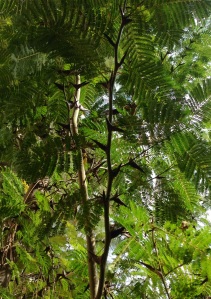
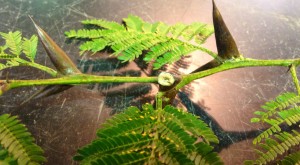
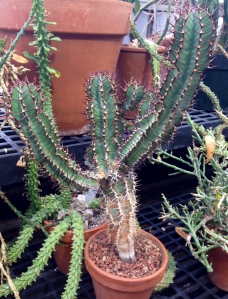
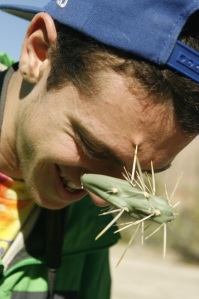
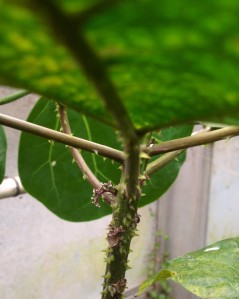
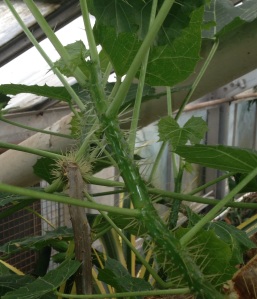

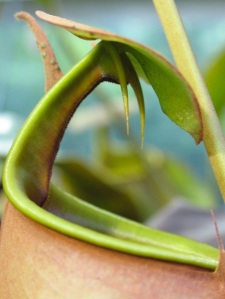
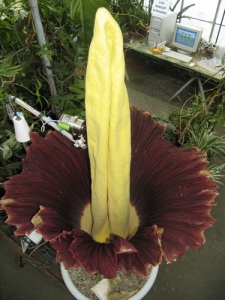
Very interesting and educational post! I love it! I learned something new today! Thanks you for sharing!